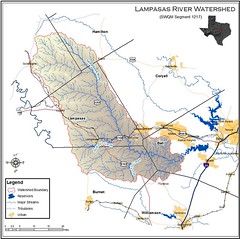Lampasas River
The Lampasas River (segment 1217 in the Brazos River Basin), rises in western Hamilton county 16 miles west of Hamilton and flows southeast for 75 miles, passing through Lampasas, Burnet, and Bell counties. In Bell County the river turns northeast and is dammed five miles southwest of Belton to form Stillhouse Hollow Lake (segment 1216). Below Stillhouse Hollow Lake, the Lampasas River flows to its confluence with Salado Creek and the Leon River to form the Little River.
 The Lampasas River is commonly characterized by relatively low water levels and is situated within a predominantly rural and agricultural landscape. Land use within the watershed is dominated by rangeland and grasslands. Major agricultural interests include the production of beef cattle on rangeland, hay, wheat, oats, sorghum, corn, cotton, peanuts, and pecans.
The Lampasas River is commonly characterized by relatively low water levels and is situated within a predominantly rural and agricultural landscape. Land use within the watershed is dominated by rangeland and grasslands. Major agricultural interests include the production of beef cattle on rangeland, hay, wheat, oats, sorghum, corn, cotton, peanuts, and pecans.
Recreational uses of the waterbody are considered to be impaired. Bacteria exceed established criteria. These organisms are generally not harmful to human health, but may indicate the presence of pathogens that can cause disease or gastrointestinal illnesses. The Lampasas River above Stillhouse Hollow Lake is listed on the 2008 Texas 303(d) List for elevated bacteria levels.
The data used to assess bacterial concentrations in the Lampasas River is the result of sampling conducted in 1998 and 1999 through the Clean Rivers Program. Fecal coliform samples were taken at 5 designated sampling sites along the Lampasas River. It was observed that two of the five sampling sites indicated a use concern or non-support of contact recreation. While E. coli samples were collected, none have been assessed within the period for the 2008 303(d) List. TCEQ has initiated a twenty-four month monitoring project at Station 15770 in the upper portion of the watershed.
Although routine sampling indicates the presence of elevated bacteria levels in the Lampasas River, the origin of this source is unclear. In order to shed light on the sources contributing to the Lampasas River bacteria impairment, library-dependent BST is needed. This approach will utilize proven scientific methods that will discriminate between the various sources of bacteria. When the sources have been identified, appropriate management measures can be implemented for the respective sources.
Through TSSWCB project 07-11, Lampasas River Watershed Assessment and Protection Project, a WPP for the Lampasas River is being developed. AgriLife-TP serves as the TSSWCB-contracted watershed coordinator for this process. The development of the Lampasas River WPP will proceed independent of this BST project; however, conclusions from this BST project will be integrated into the WPP through adaptive management.